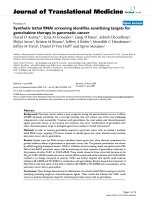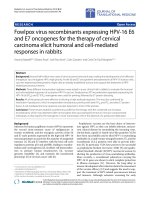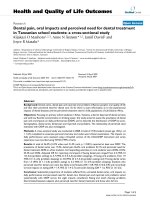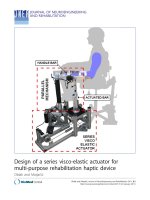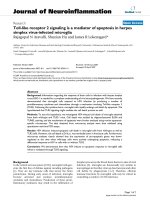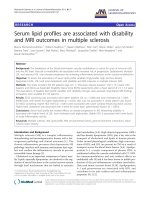Báo cáo hóa học: " Varicella-zoster virus ORF 58 gene is dispensable for viral replication in cell culture" pptx
Bạn đang xem bản rút gọn của tài liệu. Xem và tải ngay bản đầy đủ của tài liệu tại đây (1.19 MB, 9 trang )
BioMed Central
Page 1 of 9
(page number not for citation purposes)
Virology Journal
Open Access
Research
Varicella-zoster virus ORF 58 gene is dispensable for viral
replication in cell culture
Hironori Yoshii
1,2
, Kay Sadaoka
1
, Masaaki Matsuura
1,2
, Kazuhiro Nagaike
2
,
Michiaki Takahashi
3
, Koichi Yamanishi
1
and Yasuko Mori*
1
Address:
1
Laboratory of Virology and Vaccinology, Division of Biomedical Research, National Institute of Biomedical Innovation, Osaka, Japan,
2
Kanonji Institute, the Research Foundation for Microbial Diseases of Osaka University, Kanonji, Kagawa, Japan and
3
The Research Foundation
for Microbial Diseases of Osaka University, Suita, Osaka, Japan
Email: Hironori Yoshii - ; Kay Sadaoka - ; Masaaki Matsuura - ;
Kazuhiro Nagaike - ; Michiaki Takahashi - ;
Koichi Yamanishi - ; Yasuko Mori* -
* Corresponding author
Abstract
Background: Open reading frame 58 (ORF58) of varicella-zoster virus (VZV) lies at the 3'end of
the Unique long (U
L
) region and its functional is unknown. In order to clarify whether ORF58 is
essential for the growth of VZV, we constructed a deletion mutant of ORF58 (pOka-BAC∆58)
from the Oka parental genome cloned into a bacterial artificial chromosome (pOka-BAC).
Results: The ORF58-deleted virus (rpOka∆58) was reconstituted from the pOka-BAC∆58
genome in MRC-5 cells, indicating that the ORF58 gene is non-essential for virus growth.
Comparison of the growth rate of rpOka∆58 and recombinant wild-type virus by assessing plaque
sizes revealed no significant differences between them both in MRC-5 cells and malignant
melanoma cells.
Conclusion: This study shows that the ORF58 gene is dispensable for viral replication and does
not affect the virus' ability to form plaques in vitro.
Background
Varicella-zoster virus (VZV) is a member of the herpesviri-
dae family, and its primary infection causes varicella in
children. VZV often persistently infects dorsal root ganglia
(DRG) and is sometimes activated from a latent to lytic
state, causing zoster in aged and immunosuppressed indi-
viduals [1]. The double-stranded VZV genome contains
approximately 125 kbp with at least 71 open reading
flames (ORFs) [2]. Although understanding VZV virulence
and attenuation mechanisms requires study of the VZV-
encoded genes, little has been reported on VZV genes
compared with those of herpes simplex virus (HSV).
The ORF58 of VZV lies at the 3'end of the Unique long
(U
L
) region and its function is unknown. Although
ORF57, its neighboring gene, is dispensable in cell culture
[3], there has been no report yet on ORF58. Therefore, to
investigate the functional roles of this gene in VZV infec-
tion, we constructed an ORF58-deletion mutant of VZV,
and analyzed its susceptibility in both MRC-5 cells and
malignant melanoma cells.
Results and Discussion
We produced the deletion mutant of the ORF58 gene by
using the BAC system [4]. The deletion mutant of the
Published: 30 April 2008
Virology Journal 2008, 5:54 doi:10.1186/1743-422X-5-54
Received: 4 January 2008
Accepted: 30 April 2008
This article is available from: />© 2008 Yoshii et al; licensee BioMed Central Ltd.
This is an Open Access article distributed under the terms of the Creative Commons Attribution License ( />),
which permits unrestricted use, distribution, and reproduction in any medium, provided the original work is properly cited.
Virology Journal 2008, 5:54 />Page 2 of 9
(page number not for citation purposes)
ORF58 gene (pOka-BAC∆58) was constructed by recom-
bination in E. coli harboring pOka-BAC DNA [5] and
pGETrec [6] with a fragment containing the kanamycin-
resistance gene flanked by the 3'-UTR and 5'-UTR of the
ORF58 gene. The pGETrec was kindly provided by Dr.
Panayiotis A Ioannou. Thus, the ORF58 gene in the pOKa-
BAC genome was replaced by the kanamycin-resistance
gene (Fig. 1A, B, and 1C).
The recombination was confirmed by Southern blotting
using a fragment of the internal sequence of the ORF58
gene, the ORF62/71 gene, or the kanamycin-resistance
gene as a probe (Fig. 2). As shown in Figure 2, the signal
for the ORF 58 gene was detected in the pOka-BAC
genome but not in the pOka-BAC∆58 genome. The signal
for the ORF62/71 gene, used as a positive control, was
detected in both genomes, and the signal for the kanamy-
cin-resistance gene was detected in the pOka-BAC∆58
genome but not in the pOka-BAC genome. The recombi-
nation was also confirmed by PCR using primer pairs that
annealed to the internal region of the kanamycin-resist-
ance gene and the external region of ORF58 (data not
shown). The results confirmed that the ORF58 gene was
properly replaced by the kanamycin-resistant gene in the
pOka genome.
We next examined whether the ORF58 gene was essential
for the replication of VZV in MRC-5 cells. To reconstitute
the virus from its genome, MRC-5 cells were transfected
with pOka-BAC or pOka-BAC∆58 DNA (Fig. 3). At 4 days
post-transfection, typical cytopathic effects (CPEs), which
fluoresce under the exciting light, was observed in the
Construction of recombinant virus rpOka∆58Figure 1
Construction of recombinant virus rpOka∆58. (A) The VZV genome consists of two unique regions (U
L
and U
S
) and of
inverted repeat sequences (IR
L
, IR
S
, and TR
Ss
) flanking the U
S
region. An enlarged section shows the analyzed portion of the
genome, containing open reading frame (ORF) 56, 57, 58 and 59. ORFs are drawn as pointed rectangles. (B) A fragment con-
sisting of the 3'UTR of ORF58, the kanamycin-resistance gene (km
r
), and the 5'UTR of ORF58 was amplified by PCR and used
for mutagenesis of an infectious full-length pOka genome in E. coli and named Km
r
∆58. (C) The entire ORF58 gene was
replaced by the kanamycin-resistance gene in E. coli. TR
L
, terminal repeat long; U
L
, unique long; IR
L
, internal repeat long; IR
S
,
internal repeat short; U
s
, unique short; TR
S
, terminal repeat long.
57
56
58
59
TR
L
IR
L
U
L
IR
S
U
S
TR
S
98418
C
A
B
0
25000
75000
50000
125125
100000
Km
r
99149 99258 99473 100119
100149
101066
Km
r
㰱58
Km
r
56
59
Virology Journal 2008, 5:54 />Page 3 of 9
(page number not for citation purposes)
MRC-5 cells transfected with the pOka-BAC∆58 DNA, as
well as with the pOka-BAC DNA (Fig. 3), suggesting that
the ORF58 gene is dispensable for viral replication in cell
culture.
Before performing the remaining experiments, in order to
exclude the possibility to affect the packaging of viral
genome, we deleted the BAC sequences from the recom-
binant viruses derived from pOka-BAC and pOka-
BAC∆58 using the Cre-loxP system [7] (data not shown),
and the resulting viruses were named rpOka and
rpOka∆58, respectively.
Next, to confirm that rpOka∆58-infected cells did not
express the ORF58 gene, we performed RT-PCR using the
cDNA from rpOka- and rpOka∆58-infected MRC-5 cells
as a template. As shown in Figure 4, ORF58 cDNA was
amplified from the rpOka-infected cells, but not from the
pOka∆58-infected cells, indicating that the ORF58 gene
product was not expressed in the rpOka∆58-infected cells.
As positive controls, the ORF62/71 and GAPDH cDNAs
were both amplified in both types of infected cells (Fig. 4).
Since the deletion mutant rpOka∆58 was able to be recon-
stituted, we next analyzed its ability to form plaques of
rpOka∆58 with that of rpOka. Cell-free rpOka or
rpOka∆58 virus was used to infect MRC-5 cells at approx-
imately 50 PFU/well, and the resulting plaque sizes were
compared (Fig. 5) at 10 days post infection (pi), after the
infected cells were fixed and stained. As shown in Figure
5, no significant difference was observed between the
plaque sizes resulting from infection with the two viruses
(p > 0.05, Student's t-test).
In order to confirm whether rpOka∆58 grow in another
cell lines, human malignant melanoma cell line, MeWo
cells, were infected with these viruses. As shown in Figure
6, no significant difference of their plaque sizes was
observed between the two viruses (p > 0.05, Student's t-
test), suggesting that the ORF58 gene of VZV genome is
dispensable for viral replication and does not affect virus
growth in both cells. These results suggesting that the
ORF58 gene of VZV genome is dispensable for viral repli-
cation and does not affect virus growth in vitro.
Southern blotting analysis of pOka-BAC and pOka-BAC∆58. DNAFigure 2
Southern blotting analysis of pOka-BAC and pOka-BAC∆58. DNA. Purified pOka-BAC DNA and pOka-BAC∆58
DNA were digested by BamHI and loaded onto a 0.5% TBE agarose gel. The fragments recognized by the ORF58, ORF62/71
and Km
r
probes (right) are indicated by arrowheads in the photograph (left). Southern blotting was performed using ORF58,
ORF62/71, or the Km
r
gene as a probe.
10000
8000
6000
5000
pOka
㰱58
Km
r
(11734bp)
ORF62/71
(4788bp)
probe : ORF58
ORF62/71
probe : Km
r
ORF58
(10713bp)
ORF62/71
ORF58
Km
r
pOka
㰱58
pOka
㰱58
Virology Journal 2008, 5:54 />Page 4 of 9
(page number not for citation purposes)
We have succeeded in deleting the entire ORF58 gene
from the VZV genome using the BAC system. Infectious
viruses could be reconstituted from the ORF58 deletion
mutant, and the reconstituted viruses had similar growth
kinetics to wild-type VZV in cell culture.
In this study, the N terminus of ORF57 was deleted in the
process of deleting ORF58, because the C terminus of
ORF58 overlaps with the N terminus of ORF57. The
ORF57 gene product has been shown to be expressed in
the cytosol and to be dispensable for viral growth in cell
culture [3]. Therefore, we were not concerned that any
observed effects would reflect the loss of the ORF57 N-ter-
minus.
In investigations of VZV ORFs, the SCID-hu system has
been used to assess the in vivo growth and tropism of VZV
mutants constructed in cosmid systems [8-17] and BAC
[18].
In HSV-1 and HSV-2, UL3 is the positional homologue of
ORF58. The UL3 gene product is a phosphoprotein that is
localized to the cytoplasmic and nuclear portions of HSV-
1-infected cells [19]. In HSV-2-infected cells, the UL3 gene
product localizes to the nucleus at the early stage of infec-
tion [20]. Whether the ORF58 gene product possesses
similar characteristics to UL3 remains unknown. Further
study will be required to demonstrate the localization and
possible role of the ORF58 gene product in VZV infection.
Conclusion
Here we show that the ORF58 gene is dispensable for viral
replication and that the deletion mutant, rpOka∆58,
grows as same as wild-type VZV in both MRC-5 cells and
malignant melanoma cells. Construction and investiga-
tion of deletion mutants utilizing BAC system will make it
easier to understand the virulence and attenuation mech-
anisms of VZV.
Methods
Cells and viruses
MRC-5 cells were cultured with modified minimum
essential medium (MEM) supplemented with 10% fetal
bovine serum (FBS). MeWo cells were cultured with Dul-
becco's modified eagle medium (DMEM) supplemented
with 10% FBS. pOka possessing BAC sequence were
obtained previously[5]. Recombinant VZV was propa-
Reconstitution of the infectious recombinant virusFigure 3
Reconstitution of the infectious recombinant virus. (A) MRC-5 cells were transfected with purified pOka-BAC DNA or
pOka-BAC∆58 DNA. Four days after transfection, typical CPEs, which fluoresce under the exciting light, were observed in the
cells transfected with either pOka-BAC DNA or pOka-BAC∆58 DNA.
pOka-BAC
pOka-BAC㰱58
4 days post transfection
Virology Journal 2008, 5:54 />Page 5 of 9
(page number not for citation purposes)
gated by inoculation of MRC-5 cells with virus-infected
cells.
Generation of virus deletion mutants
VZV ORF58 was deleted within Escherichia coli (E. coli) by
homologous recombination using ET recombinase.
pOka-BAC clone which containing pOka full genome was
generating as described previously [5].
E. coli harboring pOka-BAC DNA was transformed by
pGETrec plasmid which express ET recombinase(kindly
provided by Dr. Panayiotis A Ioannou, Murdoch Chil-
dren's Research Institute, Department of Pediatrics, The
University of Melbourne, Royal Children's Hospital)
using MicroPulser electroporator(BIO-RAD).
To introduce homologous recombination, PCR reaction
was performed in order to generate [flanking-kanamy-
cin
R
-flanking] fragment using pCRII-TOPO plasmid (Inv-
itrogen) as template. Primer pairs were designed as
follows ; Forward
primer(ACAAATTTCTGATGTTCCCCCGGCGTGGCAAC
GCTGGCATTTCCAAACACAGAAGTTCCTATTCTCTAGA
AAGTATAGGAACTTCAGCAAGCGAACCGGA ATTGC)
contains homologous sequence of the upstream of
ORF58(ACAAATTTCTGATGTTCCCCCGGCGT-
GGCAACGCTGGCATTTCCAAACACA) as flanking
sequence, FRT sequence(GAAGTTCCTATTCTCTA-
GAAAGTATAGGAACTTC, single under line), homolo-
gous sequence of kanamycin resistant gene within pCRII-
TOPO plasmid(AGCAAGCGAACCGGAATTGC, double
under line). Reverse primer
(GATCGATTGGAGTGTTATATAACACTCCAATCGACCCT
CTCGCGTACCATGAAGTTCCTATACTTTCTAGAGAAT-
AGGAACTTCCTTTTTCAATTCAGAAGAACTC) contains
homologous sequence of the downstream of ORF58
(GATCGATTGGAGTGTTATATAACACTCCAATCGAC-
CCTCTCGCGTACCAT) as flanking sequence, FRT
sequence (GAAGTTCCTATACTTTCTAGAGAATAG-
GAACTTC, single under line), homologous sequence of
kanamycin resistant gene within pCRII-TOPO plasmid
(CTTTTTCAATTCAGAAGAACTC, double under line).
PCR products were transformed into E. coli harboring
pOka-BAC DNA and pGETrec plasmid. The recombined
clones were selected by chloramphenicol/kanamycin on
LB plates and the correct recombination was confirmed by
PCR (data not shown).
Preparation of pOka-BAC and pOka-BAC
∆
58 genome
pOka-BAC and pOka-BAC∆58 genome was isolated using
a NucleoBond BAC 100 kit (Macherey-Nagel) following
the manufacturer's protocol.
Confirming the expression of ORF58 by RT-PCRFigure 4
Confirming the expression of ORF58 by RT-PCR. rpOka or rpOka∆58-infected cells were harvested at 24 hrs p.i., and
the RNAs were extracted. The cDNAs were synthesized from each RNA using Superscript III (Invitrogen), and PCRs were
performed using the cDNAs as templates. PCRs were also performed with RT(-) to avoid amplification of contaminating
genomic DNA. The size of each product is indicated by an arrow at the right of each panel. The molecular size (bp) is shown
on the left of each panel. N.C.: negative control.
N.C.
pOka-
BAC
rpOka
㰱58
rpOka
+-+-
rpOka
+-+-
N.C.
3000
2000
1000
500
3000
2000
1000
500
452bp
569bp
N.C.
pOka-
BAC
rpOka
㰱58
rpOka
+-+-
3000
2000
1000
500
781bp
ORF58
ORF62/71
GAPDH
rpOka
㰱58
RT
RT
RT
Virology Journal 2008, 5:54 />Page 6 of 9
(page number not for citation purposes)
Reconstitution of infectious virus
One µg of pOka-BAC or pOka-BAC∆58 genome was
transfected into MRC-5 cells by electroporation using a
Nucleofection unit (Amaxa biosystems). The cells were
then cultured with MEM supplement with 10% FBS for 4
days. To remove BAC sequence, MRC-5 cells were first
infected with a recombinant adenovirus, AxCANCre,
which expresses the Cre recombinase (kindly provided by
Dr. Yasushi Kawaguchi, University of Tokyo). Twenty-four
hrs later, the cells were super-infected with the recom-
binant viruses obtained from pOka-BAC genome(rpOka-
BAC) or pOka-BAC∆58 genome(rpOka-BAC∆58), and
cultured until plaques without GFP appeared. The plaques
without GFP were isolated using glass isolation cups and
transferred onto newly prepared MRC-5 cells to obtain
BAC-deleted viruses, rpOka or rpOka∆58. After several
rounds of isolation, cell-free viruses were obtained by son-
icating the rpOka or rpOka∆58-infected cells and stored at
-80°C.
Southern blotting
Genome DNA of pOka-BAC and rpOka∆58 were
extracted from E. coli. One µg of both DNAs were digested
with BamHI and loaded onto 0.5% agarose gel and elec-
trophoresis was performed in 0.5 × TBE (44.5 mM Tris,
44.5 mM Borate, 1 mM EDTA). At 72 hour later, DNA
fragments were transferred to Hybond N
+
nylon mem-
brane(GE healthcare) with 0.4 N NaOH followed by
washing with 2 × SSC (300 mM NaCl, 30 mM Na
3
-cit-
rate). Hybridization and detection were performed using
Plaque size comparison between rpOka and rpOka∆58 in MRC-5 cellsFigure 5
Plaque size comparison between rpOka and rpOka∆58 in MRC-5 cells. Plaque sizes after infection with cell-free
rpOka and rpOka∆58 are indicated graphically (upper) and in photographs (lower). MRC-5 cells were infected with each cell-
free virus and cultured for 10 days. The cells were fixed and stained with 1% crystal violet/70% EtOH and the sizes of 38
plaques (rpOka) and 41 plaques (rpOka∆58) were calculated and analyzed using ImageJ software (NIH, USA). Error bars in the
graph indicate the standard deviation (SD).
Virology Journal 2008, 5:54 />Page 7 of 9
(page number not for citation purposes)
ECL direct labeling and detection system (GE healthcare).
Probes used to detect ORF58, ORF62 and kanamycin
resistant gene were labeled using the system following
manufacture's protocol. The primer pairs used to create
probes were: ORF58, VZ58F (aggacacgatctaaagccgt) and
VZ58R (tccgtaccgacggcattgct); ORF62/71, G62N4 (gat-
caaagcttagcgcag) and G62R4 (cctatagcatggctccag); kan-
amycin-resistance gene, KMF (atgattgaacaagatggattg) and
KMR (aagaaggcgatagaaggcgatg). The transferred mem-
brane was treated with hybridization buffer for 2 hours at
42°C followed by hybridization with the labeled probes
for 18 hours at 42°C following manufacture's protocol,
then was washed with primary wash buffer (6 M urea,
0.4% SDS and 0.5 × SSC) for 4 times at 42°C followed by
washing with secondary wash buffer (2 × SSC), and the
Plaque size comparison between rpOka and rpOka∆58 in MeWo cellsFigure 6
Plaque size comparison between rpOka and rpOka∆58 in MeWo cells. Plaque sizes after infection with cell-free
rpOka and rpOka∆58 are indicated graphically (upper) and in photographs (lower). MeWo cells were infected with each cell-
free virus and cultured for 10 days. The cells were fixed and stained with 1% crystal violet/70% EtOH and the sizes of 282
plaques (rpOka) and 208 plaques (rpOka∆58) were calculated and analyzed using ImageJ software (NIH, USA). Error bars in
the graph indicate the standard deviation (SD).
㪇
㪇㪅㪈
㪇㪅㪉
㪇㪅㪊
㪇㪅㪋
㪇㪅㪌
㫉㫇㪦㫂㪸 㫉㫇㪦㫂㪸㰱㪌㪏
㫇㫃㪸㫈㫌㪼㩷㫊㫀㫑㪼㩿㫄㫄
㪉
㪀
rpOka rpOka㰱58
Virology Journal 2008, 5:54 />Page 8 of 9
(page number not for citation purposes)
signals were detected with ECL detection reagents (GE
healthcare) followed by exposing to X-ray film.
RT-PCR
rpOka or rpOka∆58-infected cells were harvested at 24
hours p.i. Cells were extracted with 1 mL of TRIzol Rea-
gent (Invitrogen) and 200 µL of chloroform. Cell extract
was centrifuge and supernatant was added with 500 µL of
isopropanol. Nucleic acid containing total RNA was
obtained by centrifuge and resolved with 20 µL of DEPC-
treated water. Seven µL of solution was added with 2 µL of
10× DNase buffer and 1 µL of DNaseI and incubated for
20 minutes followed by added with 1 µL of 25 mM EDTA
and incubated at 60°C for 20 minutes thereafter trans-
ferred on ice. Eight micro litters of solution was added
with 1 µL of oligo(dT)
15
and 4 µL of dNTP(2.5 mM each)
and incubated at 65°C for 5 minutes thereafter incubated
on ice for 5 minutes. Solution was then added with 4 µL
of 5× buffer, 1 µL of 0.1 M DTT, 1 µL of RNase inhibitor
and 1 µL of SuperScriptIII reverse transcriptase(Invitro-
gen) and incubated at 50°C for 60 minutes followed by
incubated at 70°C for 15 minutes. Single stranded RNA
was digested from DNA/RNA hybrid by adding 0.5 µL of
RNaseH and incubated at 37°C for 20 minutes.
Expression of mRNAs were confirmed using primers set
anneal to ORF58 (forward primer: VZ58F (aggacac-
gatctaaagccgt), reverse primer: VZ58R (tccgtaccgacggcatt-
gct)), ORF62 (forward primer: G62N4
(gatcaaagcttagcgcag), reverse primer: G62R4 (cctatagcat-
ggctccag)) and GAPDH (forward primer: G3PDHF
(accacagtccatgccatcac), reverse primer: G3PDHR (tccac-
caccctgttgctgta)). pOka-BAC DNA was used as positive
control.
Comparison of Plaque sizes
VZV recombinants were assessed for the property of cell-
to-cell spread by comparison of plaque sizes. Briefly,
MRC-5 cells or MeWo cells were infected with approxi-
mately 50 PFU of cell-free viruses of rpOka or rpOka∆58,
which was produced from pOka-BAC or pOka-BAC∆58
genome. The cells were cultured for 7 days at 37°C fol-
lowed by stained with 1% crystal violet/70% ethanol.
Plaque sizes were calculated with ImageJ software (NIH,
USA).
Competing interests
The authors declare that they have no competing interests.
Authors' contributions
HY and YM designated research; HY, KS, MM and KN per-
formed research; HY, MT, KY and YM analyzed data; and
HY and YM wrote the paper.
Acknowledgements
We thank Dr. Ulrich Koszinowski (Max von Pettenkofer institute, Ger-
many) for providing the plasmid, pHA-2, Dr. Yasushi Kawaguchi (University
of Tokyo, Japan) for providing the AxCANCre, and Dr. Panayiotis A Ioan-
nou (Murdoch Children's Research Institute, Department of Pediatrics, The
University of Melbourne, Royal Children's Hospital, Australia) for providing
the pGETrec plasmid. This work was supported in part by a grant for
Research Promotion of Emerging and Re-emerging Infectious Diseases
(H18-Shinko-004) from the Ministry of Health, Labour and Welfare of
Japan.
References
1. Arvin AM: Varicella-zoster virus. Clin Microbiol Rev 1996,
9(3):361-381.
2. Cohen JI, Straus SE, Arvin AM: Varicella-Zoster Virus Replica-
tion, Pathogenesis, and Management. In Fields VIROLOGY 5th
edition. Edited by: Knipe D, Griffin D, Lamb R, Straus S, Howley P,
Martin M, Roizman B. Philadelphia: Lippincott Williams & Wilkins, a
Wolters Kluwer Business; 2007:2773-2818.
3. Cox E, Reddy S, Iofin I, Cohen JI: Varicella-zoster virus ORF57,
unlike its pseudorabies virus UL3.5 homolog, is dispensable
for viral replication in cell culture. Virology 1998,
250(1):205-209.
4. Brune W, Messerle M, Koszinowski UH: Forward with BACs: new
tools for herpesvirus genomics. Trends Genet 2000,
16(6):254-259.
5. Nagaike K, Mori Y, Gomi Y, Yoshii H, Takahashi M, Wagner M, Koszi-
nowski U, Yamanishi K: Cloning of the varicella-zoster virus
genome as an infectious bacterial artificial chromosome in
Escherichia coli. Vaccine 2004, 22(29–30):4069-4074.
6. Narayanan K, Williamson R, Zhang Y, Stewart AF, Ioannou PA: Effi-
cient and precise engineering of a 200 kb beta-globin human/
bacterial artificial chromosome in E. coli DH10B using an
inducible homologous recombination system. Gene Ther 1999,
6(3):442-447.
7. Kanegae Y, Lee G, Sato Y, Tanaka M, Nakai M, Sakaki T, Sugano S,
Saito I: Efficient gene activation in mammalian cells by using
recombinant adenovirus expressing site-specific Cre recom-
binase. Nucleic Acids Res 1995, 23(19):3816-3821.
8. Moffat JF, Zerboni L, Kinchington PR, Grose C, Kaneshima H, Arvin
AM: Attenuation of the vaccine Oka strain of varicella-zoster
virus and role of glycoprotein C in alphaherpesvirus viru-
lence demonstrated in the SCID-hu mouse. J Virol 1998,
72(2):965-974.
9. Moffat JF, Zerboni L, Sommer MH, Heineman TC, Cohen JI,
Kaneshima H, Arvin AM: The ORF47 and ORF66 putative pro-
tein kinases of varicella-zoster virus determine tropism for
human T cells and skin in the SCID-hu mouse. Proc Natl Acad
Sci USA 1998, 95(20):11969-11974.
10. Sato B, Ito H, Hinchliffe S, Sommer MH, Zerboni L, Arvin AM: Muta-
tional analysis of open reading frames 62 and 71, encoding
the varicella-zoster virus immediate-early transactivating
protein, IE62, and effects on replication in vitro and in skin
xenografts in the SCID-hu mouse in vivo. J Virol 2003,
77(10):5607-5620.
11. Besser J, Sommer MH, Zerboni L, Bagowski CP, Ito H, Moffat J, Ku
CC, Arvin AM: Differentiation of varicella-zoster virus ORF47
protein kinase and IE62 protein binding domains and their
contributions to replication in human skin xenografts in the
SCID-hu mouse. J Virol 2003, 77(10):5964-5974.
12. Baiker A, Fabel K, Cozzio A, Zerboni L, Fabel K, Sommer M, Uchida
N, He D, Weissman I, Arvin AM: Varicella-zoster virus infection
of human neural cells in vivo. Proc Natl Acad Sci USA 2004,
101(29):10792-10797.
13. Moffat J, Mo C, Cheng JJ, Sommer M, Zerboni L, Stamatis S, Arvin AM:
Functions of the C-terminal domain of varicella-zoster virus
glycoprotein E in viral replication in vitro and skin and T-cell
tropism in vivo. J Virol 2004, 78(22):12406-12415.
14. Ito H, Sommer MH, Zerboni L, Baiker A, Sato B, Liang R, Hay J,
Ruyechan W, Arvin AM: Role of the varicella-zoster virus gene
product encoded by open reading frame 35 in viral replica-
tion in vitro and in differentiated human skin and T cells in
vivo. J Virol 2005, 79(8):4819-4827.
Publish with BioMed Central and every
scientist can read your work free of charge
"BioMed Central will be the most significant development for
disseminating the results of biomedical researc h in our lifetime."
Sir Paul Nurse, Cancer Research UK
Your research papers will be:
available free of charge to the entire biomedical community
peer reviewed and published immediately upon acceptance
cited in PubMed and archived on PubMed Central
yours — you keep the copyright
Submit your manuscript here:
/>BioMedcentral
Virology Journal 2008, 5:54 />Page 9 of 9
(page number not for citation purposes)
15. Schaap A, Fortin JF, Sommer M, Zerboni L, Stamatis S, Ku CC, Nolan
GP, Arvin AM: T-cell tropism and the role of ORF66 protein in
pathogenesis of varicella-zoster virus infection. J Virol 2005,
79(20):12921-12933.
16. Berarducci B, Sommer M, Zerboni L, Rajamani J, Arvin AM: Cellular
and viral factors regulate the varicella-zoster virus gE pro-
moter during viral replication. J Virol 2007, 81(19):10258-10267.
17. Che X, Berarducci B, Sommer M, Ruyechan WT, Arvin AM: The
ubiquitous cellular transcriptional factor USF targets the
varicella-zoster virus open reading frame 10 promoter and
determines virulence in human skin xenografts in SCIDhu
mice in vivo. J Virol 2007, 81(7):3229-3239.
18. Zhang Z, Rowe J, Wang W, Sommer M, Arvin A, Moffat J, Zhu H:
Genetic Analysis of Varicella-Zoster Virus ORF0 to ORF4 by
Use of a Novel Luciferase Bacterial Artificial Chromosome
System. J Virol 2007, 81(17):9024-9033.
19. Ghiasi H, Perng GC, Cai S, Nesburn AB, Wechsler SL: The UL3
open reading frame of herpes simplex virus type 1 codes for
a phosphoprotein. Virus Res 1996, 44(2):137-142.
20. Yamada H, Jiang YM, Zhu HY, Inagaki-Ohara K, Nishiyama Y: Nucle-
olar localization of the UL3 protein of herpes simplex virus
type 2. J Gen Virol 1999, 80(Pt 8):2157-2164.


